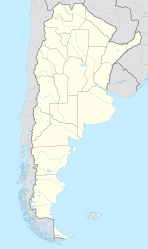San Carlos de Bariloche
|
San Carlos de Bariloche Bariloche |
||
|---|---|---|

The Civic Centre and port
|
||
|
||
| Coordinates: 41°09′S 71°18′W / 41.150°S 71.300°W | ||
| Country |
|
|
| Province |
|
|
| Department | Bariloche | |
| Established | 1902 | |
| Government | ||
| • Intendant | Gustavo Gennuso | |
| Area | ||
| • City | 220.27 km2 (85.05 sq mi) | |
| Elevation | 893 m (2,930 ft) | |
| Population (2010) | ||
| • City | 113,450 | |
| • Density | 520/km2 (1,300/sq mi) | |
| • Urban | 113,450 | |
| • Metro | 130,000 | |
| Time zone | ART (UTC−3) | |
| Climate | Csb | |
| Website | Official website | |
San Carlos de Bariloche, usually known as Bariloche (Spanish pronunciation: [baɾiˈlotʃe]), is a city in the province of Río Negro, Argentina, situated in the foothills of the Andes on the southern shores of Nahuel Huapi Lake. It is located within the Nahuel Huapi National Park. After development of extensive public works and Alpine-styled architecture, the city emerged in the 1930s and 1940s as a major tourism centre with skiing, trekking and mountaineering facilities. In addition, it has numerous restaurants, cafés, and chocolate shops. The city has a permanent population of 108,205 according to the 2010 census.
The name Bariloche comes from the Mapudungun word Vuriloche meaning "people from behind the mountain" (vuri = behind, che = people). The Poya people used the Vuriloche pass to cross the Andes, keeping it secret from the Spanish priests for a long time.
Nahuel Huapi lake was known to Spaniards since the times of the Conquest of Chile. Following the trails of the Mapuche people across the Andes, in the summer of 1552–1553, the Spanish Governor of the Captaincy of Chile Pedro de Valdivia sent Spanish Conquistador Francisco de Villagra to explore the area east of the Andes at the latitudes of the city of Valdivia. Francisco de Villagra crossed the Andes through Mamuil Malal Pass and headed south until reaching Limay River in the vicinity of Nahuel Huapi Lake.
Another early Spaniard to visit the zone of Nahuel Huapi Lake was the Jesuit priest Diego de Rosales. He had been ordered to the area by the Governor of Chile Francisco Antonio de Acuña Cabrera y Bayona, who was concerned about the unrest of the native Puelche and Poya after the slave-hunting expeditions carried out by Luis Ponce de León in 1649, who captured Indians and sold them into slavery. Diego de Rosales started his journey at the ruins of Villarica in Chile, crossed the Andes through Mamuil Malal Pass, and traveled further south along the eastern Andean valleys, reaching Nahuel Huapi Lake in 1650.
...
Wikipedia


